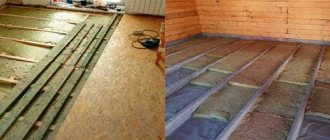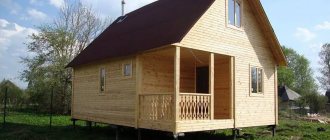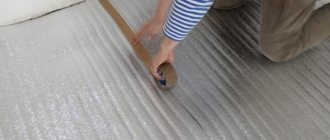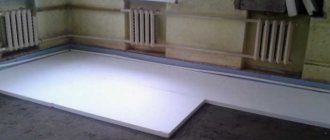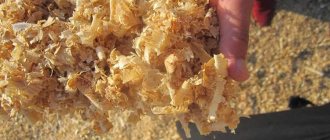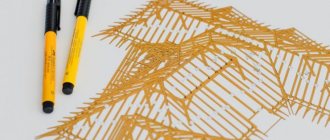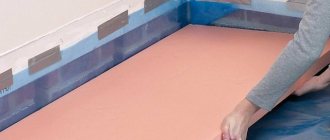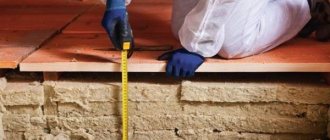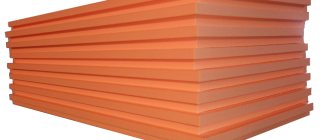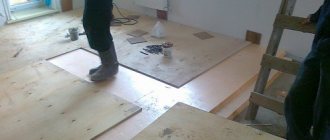Insulation of the room is an important stage during renovation. The most common is thermal insulation of floors. There are a large number of thermal insulation materials. Most often, builders use mineral wool for such purposes.
Since floor insulation with mineral wool is a labor-intensive process, it is necessary to study each stage in detail, study the advantages and disadvantages of this insulation, the types and criteria for choosing one of them.
Many people, before carrying out the floor insulation procedure, are faced with the problem of choosing insulation. Most often the question arises: what is better to use expanded clay or mineral wool. In most cases, preference is given to a mineral coating, since its installation process is easy; you can do it yourself, without the help of outsiders.
Detailed description of the technology
First of all, the base (subfloor) is prepared.
The floor needs to be repaired, all cracks repaired, and leveled. Treat the wooden floor with an antiseptic. Cracks in a concrete floor can be repaired with cement mortar or polyurethane foam, with further removal of excess. Coat the dirt floor with clay. At the final stage, dry and clear of debris. After preparation, waterproofing is carried out - a polyethylene film or membrane is laid on the base. If one sheet is missing, and in most cases this is the case, the film is laid overlapping, that is, so that one edge of the film lies on the other, at a distance of 10-15 cm. The sheets are fastened together with adhesive tape or double-sided tape. This process requires maximum care when working on concrete floors, as it is easiest to tear the film or membrane on them.
Installation of logs is the most important stage of work. The logs are made of wooden beams and installed between the walls in increments equal to the width of the insulation sheets. Most often, the width of the sheets is 1 meter. This means that the logs should be installed in increments of 1 m. Sometimes it is recommended to do a little less so that the gaps are minimal. To fasten the lags, dowel-nails with screws are used.
It is extremely important that all joists are strictly horizontal. This is the main condition for a flat floor to be installed on them.
A long liquid or laser level is used to level them.
Work begins with the installation of side joists running along the walls. Drive short ones between the long bars so that you get cells slightly smaller in size than the size of the insulation sheets. If cotton wool in rolls is used as insulation, there is no need to make jumpers between the joists.
At the end of the work, the entire system is thoroughly treated with an antiseptic. Once again check the horizontal position using a level.
Insulation sheets are laid. If the cells were made slightly smaller than a sheet of mineral wool, then it is enough to slightly compress the wool. When it falls into place, it straightens out and fills all the cracks. It is better to cut the foam at the place of installation. This will help avoid even the slightest cracks.
A hydrobarrier is also installed on top of the insulation. It can be either polyethylene film or specialized materials with or without a metallized layer. This is necessary to protect the insulation in cases where something is spilled on the floor.
As with the bottom film, the sheets are laid overlapping so that the edges overlap each other by 10-15 cm. The joints are sealed with double-sided tape or adhesive tape.
A lining for the finished plywood floor is mounted on top. Plywood sheets are fastened with self-tapping screws or clamps. As a rule, the distance between the walls is first measured. The plywood sheets are marked so that the plywood covering is approximately 1 cm away from the walls. The fact is that the plywood lining can expand as it is installed, and it is better to compensate for this expansion in advance. And the remaining gap will then be closed with skirting boards.
When laying plywood, you need to ensure that the joints are located in the center of the joists. To achieve this, the sheets are trimmed with an electric jigsaw or circular saw.
In addition, we must not forget that as you move around the room, its width may change up or down. Accordingly, the width of the plywood sheets should be adjusted.
The biggest challenge will be installing the last sheets of plywood. They will have to be cut not only along, but also across. The entire resulting structure is once again treated with an antiseptic solution.
The finished floor can be installed on the resulting plywood lining.
In some cases, in order to eliminate possible gaps, two-layer floor insulation is done. In this case, the second layer is located across the first. That is, another joist structure is attached on top of the first layer and another layer of insulation with appropriate waterproofing is laid.
Technology and stages of work
The multi-stage process of arranging floor thermal insulation is carried out taking into account the specifics of the technology, which implies a clear algorithm of operation.
Materials and tools
Before starting work, you must prepare the following set of tools and accessories:
- roulette;
- large stationery knife, scissors;
- construction stapler;
- aluminum coated tape.
Tools for dismantling old flooring and repairing/constructing a new multi-layer base structure:
- screwdriver;
- nail puller;
- hammer;
- pliers;
- set of hardware.
You should also ensure that you have protective clothing, a respirator, and goggles. It is necessary to take into account that to work with glass wool and slag wool you will need rubber gloves; other processes are carried out in simple cotton gloves.
Preparatory work
The process begins with removing the old flooring. If you are going to dismantle the finishing layer, which you plan to use again, it is advisable to carefully remove the elements and mark them for ease of re-installation. Next, clean the surface of the subfloor from debris and dust.
Leveling the surface
If, when checking the rough foundation, defects in the form of unevenness, cracks, chips or depressions are revealed, a set of works is carried out to eliminate them. This is necessary to ensure a tight fit of the insulating layer to the surface being constructed. After eliminating the defects of the concrete base, they begin to level the surface using a screed. The modern construction industry offers a wide variety of leveling methods, among which it is not difficult to choose the best option depending on your budget.
Laying vapor barrier
Vapor barrier
After the screed has completely dried to protect the insulation, the concrete base is covered with polyethylene film for vapor barrier. As experts note, a special membrane is a priority for these purposes. The product is a thick canvas made of several layers of waterproofing materials. The vapor barrier is carefully leveled and pressed tightly against the screed, overlapping the wall, taking into account the height of the guides and mineral insulation.
Installation of guides
Thermal insulation of a wooden floor along the joists allows you to lay the mineral wool tightly and evenly, and the pace of work is also accelerated. To install the guides correctly, the following points must be considered:
- the working interval between the logs depends on the parameters of the insulation and the scale of the space being developed;
- preliminary calculations should be carried out to ensure that the gaps between the lags are identical;
- the maximum distance between guides should not exceed 1 m.
Also, gaps between the guides and the perimeter of the wall are not allowed.
Laying mineral wool between joists
Installation of mineral wool
When preparing the insulation, the material is cut with a margin of 1 cm around the perimeter in order to eliminate gaps between the insulator and the joists during installation. Mineral wool is laid in 1 or 2 layers. In this case, the second layer of coating is laid so that the joints of the lower layer are covered with the upper one using the bricklaying method.
Waterproofing
Since the mineral insulator is susceptible to moisture, the next step is to protect the coating with the selected waterproofing agent. This layer is an analogy of a vapor barrier and consists of dense polyethylene.
Finished floor installation
Features of floor insulation
Floor thermal insulation diagram.
Mineral wool must be used in conjunction with other materials, among them there must be various membranes, vapor barrier films, etc. When choosing mineral wool, you should remember that the material that is made on the basis of fiberglass can demonstrate increased fragility. In order to eliminate this drawback, some manufacturers add a number of chemical additives, for example, formaldehyde. But it has a bad effect on the human body. It is for this reason that you should prefer mineral wool made on the basis of basalt fiber - this material is completely safe.
Before the process of insulating the floor of a wooden house, you should decide what type of material to prefer. Insulation can be represented by rigid mats, flexible slabs and rolls. According to the standard, the classification is much broader, however, for high-quality and effective insulation, one of the above types of mineral wool can be used.
The technological process of thermal insulation is divided into 5 separate stages. The first stage involves installing the lower floor covering. To do this, you can choose continuous plank flooring, which is true for a house that does not have a basement; You can also choose sand preparation, which is applicable in the case of a ground floor and the presence of a basement. The second stage of work involves waterproofing. This will prevent the penetration of water during the period of snow melting or the spring rise of groundwater. The next stage will be mineral wool flooring. In this case, the slabs should be laid as closely as possible to each other so as to avoid the formation of gaps. When rolling out a roll, avoid the formation of unwanted gaps. Next, the floors in a wooden house should be covered with a layer of vapor barrier, after which you can proceed to the installation of the finished floor. This should be done along special bars designed to provide an air gap between the insulation and the floor boards.
Sequence of floor insulation
Insulation of the floor of a wooden or stone house can be divided into several stages:
- 1. Preliminary preparatory work.
- 2. Laying waterproofing.
- 3. Installation of insulating materials.
- 4. Vapor barrier of the floor.
- 5. Rough finishing, finishing and surface reinforcement.
Thermal insulation work is carried out using mineral wool, according to developed schemes, each of which may differ.
Ground surface using brick pillars
Fastening elements are used to fix the floor joists. Along the entire length of the logs, wooden blocks are placed, through which the flooring is laid. Up to the top point of the columns, the internal space is filled with expanded clay. Mineral or stone wool, waterproofing components are laid on top of the logs. A vapor barrier is placed on top, and all joints are taped with construction tape.
Compacted soil
It is a traditional flooring design for modern country houses. The working surface is laid on support beams installed on compacted soil or gravel. Stone or mineral wool is placed after filling the space with expanded clay and placing waterproofing. It is advisable to install the mats as tightly as possible, without gaps. A vapor barrier is usually placed on top, followed by a reinforced screed or subfloor.
Concrete base
Initially, a vapor barrier is installed so that the foil side faces the stove. Then comes mineral wool, which can be laid with or without lathing. As in previous schemes, it is recommended to avoid gaps and irregularities. The final layer should be a vapor barrier.
Instructions for insulating an attic floor with mineral wool
Mineral wool is preferred by builders due to its resistance to fire and rodents.
It also does not rot, the only thing it is afraid of is liquid. Insulating an attic floor with mineral wool consists of several stages:
- Spread glassine on the attic floor. If financial resources allow, it is better to buy a special vapor barrier film, because ideally a vapor barrier is also needed.
- The film is overlapped, and the joints should be covered with tape or secured with wooden slats, secured with a special tool - a construction stapler.
- Armed with mineral wool, you need to decide on the volume of the substance used, having previously studied the heat standards for your region.
- When working with mineral wool, lay it tightly so that there are no joints or empty spaces. Additionally, the seams are taped.
- The top layer, placed on top of the logs, is boards, which, in principle, form the floor of the attic. This maneuver will allow the insulation to “breathe” and avoid the appearance of mold if liquid suddenly gets on the mineral wool.
Do not forget that when working with mineral wool, it is necessary to use protective equipment, this can be thick clothing with long sleeves, glasses, thick gloves and a respirator that protects against foreign substances entering the respiratory tract.
Insulation of a mineral wool attic is shown in the video: https://www.youtube.com/watch?v=MbQ686qYvco
Completion of work
After reliably insulating the floor, it’s time to think about what the surface will look like. It is recommended to lay (and fix) a strong and thick material on top of the thermal insulation layer, which evenly distributes the load across the joists. This can be an ordinary board (for example, an inch), fiberboard, chipboard, construction plasterboard, thick plywood. It is permissible to lay carpets, laminate, parquet, and so on on top of the selected coating; further steps are at the discretion of the residents of the house.
In conclusion, some useful advice: do not try to save on thermal insulation material by purchasing products from little-known manufacturers at extremely low prices.
The problems that arise from being too frugal with money result in even more spending. Shrinkage of the heat insulator, the formation of fungus, mold, microorganisms, unpleasant odor inside the house, rotting joists are just some of the troubles, the elimination of which will significantly impact the budget.
It is not difficult to insulate the floor yourself. It is enough to follow the above instructions, carefully monitor the progress of work and not make a mistake when purchasing mineral wool. If all conditions are met, the floor of your home will be insulated for many decades to come.
Mineral wool differences
As we have already said, there are three types of mineral wool insulation. Each of them is made from different raw materials and has its own properties.
Advantages:
- Breathability.
- Fire resistance.
- Elasticity, vibration resistance.
- Withstands low temperatures.
- Lower cost than other mineral wool.
Minuses:
- Short shelf life - 5-10 years.
- Shrinkage 80%.
- Strongly absorbs moisture.
- If it comes into contact with the skin, it causes itching or even an allergic reaction.
As for the scope of application, it is usually mineral wool for insulating walls inside the house.
Slag
Produced from metallurgical waste. Inferior in characteristics to other types of insulation.
- Does not provide adequate sound insulation.
- Does not withstand strong heat. It does not burn, but it sinteres and loses its thermal insulation qualities.
- Does not tolerate temperature changes.
- Protective clothing and a respirator for installation are also required.
- It is impossible to insulate damp rooms with metal fasteners, since under the influence of moist air, slag will promote corrosion.
- High hygroscopicity.
Plus, such a layer in the wall does not attract rodents and insects. Most often used on dry surfaces of temporary buildings or non-residential buildings.
Stone
The most expensive material. It is usually chosen for exterior work in private houses, including frame wooden houses. Rocks are used in production. Thanks to this, the final product has many advantages:
- High density and therefore strength.
- Fire resistance. Does not ignite at any temperature.
- Minimum shrinkage (5%).
- Long service life (up to 50 years).
- Provides excellent sound insulation.
- Almost does not break during operation, which happens with other types of products.
- Vapor permeability. The fibers repel moisture.
The downside is the high cost. Despite all the advantages, it is not always rational to insulate with these slabs.
Required materials and tools
To insulate the floor with mineral wool under the screed and along the joists, you need to purchase basic and auxiliary materials on the construction market, as well as complete a set of tools (borrow from friends or neighbors, rent from specialized companies).
Materials you will need:
- mineral wool for floor insulation;
- logs made of well-dried timber;
- sheets of OSB, plywood or gypsum fiber board - laid on logs under laminate, parquet, ceramic tiles;
- wood screws 3-4 cm long for attaching the log to a metal corner or U-shaped profile;
- self-tapping dowels - the corners and profile are attached to the concrete base of the floor;
- U-shaped metal profile, studs or corners - connect the logs to the floor slab;
- primer;
- waterproofing materials (polyethylene film, roofing felt, mastics, etc.);
- metallized tape;
- vapor barrier film or membrane.
The list of necessary tools:
- perforator;
- screwdriver with cross bits;
- jigsaw or wood saw;
- roulette;
- construction knife;
- level;
- marker or construction pencil;
- construction stapler.
The nuances of floor insulation with mineral wool
When arranging the floor in a private house, fiber insulation is used in the following cases:
- for insulating the base above the basement floor. The basement space is most often not heated, and under the influence of cold air from below, the floor slabs do a poor job of saving heat in the room. As experts note, the cold intensively enters the house through the uninsulated base, which causes the leakage of a considerable part of the thermal energy from the room;
- for heat and sound insulation of interfloor ceilings. Mineral wool in a multi-layer construction of floors between floors is positioned as the optimal thermal insulation option. The use of insulation with a fibrous structure makes it possible to maintain an independent microclimate in rooms located at different levels of the building. The high noise absorption properties of this material help create a reliable barrier against the spread of sound effects, which often occur during the operation of household appliances or utilities;
- for arranging the attic floor. The under-roof space is constantly exposed to aggressive climatic conditions. Seasonal frost or heat, dampness and wind loads negatively affect the condition of the attic floor. To protect the structure from external influences, it is recommended to equip a complex barrier made of mineral wool and hydro- and vapor barrier products.
Mineral wool is available in rolls, slabs and flexible mats with various technical characteristics. Rolled products provide low rigidity, the width of the products is 0.6 and 1.2 m, the length is up to 10 m. The material is relevant when arranging large areas, as it allows you to minimize the number of joints in the heat-insulating layer. To install the rolls, a sheathing is made, and the insulation is laid in two layers.
Mineral wool in slabs
Slabs made of mineral fibers with a dense structure are mainly used for arranging soil foundations. The material is laid without lathing and filled with mortar. Mineral wool in slabs contains hydrophobized components. One side of the product is more rigid than the other. The manufacturer's instructions indicate installation requirements taking into account the characteristics of the product. The factory packaging of tile insulation is designed to cover an area of 1-4 m² in one layer. Dimensions: 50x100 cm.
The front surface of the flexible mat with a hydrophobized composition is laminated using perforated kraft paper. When installing the insulator, the treated side should lie in the direction of the insulated space.
When planning floor insulation with mineral wool in a private house, the following nuances should be taken into account:
- the thickness of mineral wool for insulating a wooden or concrete floor is selected depending on the operating conditions, including the purpose of the area being developed and the climatic features of the area;
- It is recommended to insulate the foundations of houses in the southern regions with 50 mm thick mineral insulator models. A material with similar characteristics is also suitable for arranging the floor in a country house, which is used exclusively in the warm season;
- on interfloor floors, an insulating resource made of mineral fibers 50 mm thick is used due to the low requirements for environmental temperature parameters in a given space;
- For high-quality thermal insulation of the floor in a country house, mineral insulation with a layer thickness of up to 200 mm is required.
Advantages and disadvantages
The leadership of mineral wool in the environment of floor thermal insulation in the house is determined by the following points:
- high class of non-flammability. An insulator of this category is a barrier to the spread of fires. Varieties of the product are characterized as means of additional fire protection of structures for various purposes. The material is relevant, including when arranging fire-hazardous structures. For example, the operating temperature range of stone wool varies up to +1000°C;
- low thermal conductivity coefficient. The fibrous structure provides an air layer that prevents the transfer of thermal energy. If the installation technology is followed, this type of insulation helps maintain a comfortable microclimate in the room;
- high noise absorption rates. The composition is able to actively resist the propagation of sound waves. Due to its decent sound insulation characteristics, this insulating agent is applicable in various structures, including roofing pie, construction of interfloor ceilings or engineering infrastructures in the house;
- frost resistance. The material is not exposed to negative temperatures and is able to provide maximum protection against heat loss, regardless of the climatic conditions of the area;
- vapor permeability. The composition compares favorably with other insulators by its ability to “breathe”;
- inertness to chemical and biological threats. Insulation based on mineral fibers does not react to the effects of active chemical compounds and pathogens;
- ease of installation. It is convenient to fill any volume of space with mineral wool, since the composition is lightweight and of sufficient thickness;
- efficiency. The material is sold in an affordable segment, which is due to the simplicity of the manufacturing process.
It is convenient to fill any volume of space with mineral wool, since it is light in weight and of sufficient thickness.
When planning thermal insulation of the floor with mineral wool, you should be aware of the disadvantages of the resource:
- impressive volume in height. The thickness of the insulating product is of considerable importance when organizing a frame made of wooden logs; this argument negatively affects the overall height of the floor structure;
- exposure to moisture. Not all varieties of mineral wool have moisture-resistant properties. For example, glass wool and slag wool lose their functionality when exposed to a humid environment. Compositions made from volcanic rocks - basalt - are highly resistant to moisture;
- certain difficulties in installation. To work with glass wool and slag wool, you must use special clothing and accessories. It is necessary to avoid direct contact with the composition of small particles with sharp ends that can damage the skin, respiratory tract and eyes.
A big disadvantage is the unsafety of certain types of mineral wool due to the presence of chemical components in the composition. When exposed to high temperatures, compounds are released that are harmful to health and the environment. At the same time, the basalt variety of mineral insulation is quite safe and is used when arranging floors and other structures in the house.
Resources based on mountain volcanic rocks are characterized as effective heat and sound insulation agents. In addition, stone insulator provides high fire resistance, resistance to mechanical loads and moisture. The only disadvantage of basalt insulation is its relative high cost compared to slag and fiberglass.
How to choose mineral wool products
First you need to pay attention to several characteristics:
- Thickness of mineral wool for wall insulation. The thicker the insulating layer, the higher its fire safety, sound insulation and strength. For interior partitions and frame structures, mats of 5 cm are suitable. For facades - from 5 to 10 cm.
- Density (P). We wrote about it above. The rigidity of the structure and its ability to withstand loads depend on it. For facades, the indicator should be in the range of 100-125 kg/m³. If plaster is chosen as finishing, then 150 kg/m³. For interior partitions - 75-90 kg/m³.
- Thermal conductivity. The smaller it is, the better. In this regard, basalt and fiberglass products have proven themselves well.
- Vapor permeability. The coefficient suitable for private buildings is that of stone wool. Designated MU1. The larger it is, the better the product.
- Fire resistance. The fire resistance level of fiberglass is 600⁰ C, material made of rock alloys is 1000º C.
What else to pay attention to
If you are planning work on the outside of the building, choose basalt slabs. When it is necessary to insulate from the inside, fiberglass coating is also suitable. When purchasing, look at the storage conditions.
- If the product gets even a little wet, there is no point in purchasing it. Check that there are no tears in the packaging.
- Blocks and rolls should be kept under cover and not outdoors.
The most famous manufacturers of mineral insulation are Isover, URSA, Rockwool, Knauf. Their products are certified and quality tested.
Material selection criteria
The key criterion for choosing mineral wool for floor insulation is the density of the material. To create a multi-layer base structure when arranging residential premises, priority is given to rolled products with characteristics of 35-40 kg/m³. If you plan to use a tiled insulator, choose a model with parameters up to 90 kg/m³. High-rigidity blocks are also used in industrial facilities.
To insulate a wooden floor, mineral wool in rolls is usually chosen with the calculation of laying in 2 layers. In some cases, it is preferable to use flexible mats with a fibrous structure. Thermal insulation material must be equipped with a vapor barrier membrane and a hydrobarrier in the form of a film.
For concrete floors, preference is given to slabs of appropriate density. If laying under a screed is to be done, rigid models with a density of 150 kg/m³ and the lowest possible thermal conductivity coefficient are used.
For insulation of wooden floors, mineral wool in rolls is mainly chosen
Styrofoam
Usually this word refers to foamed polystyrene and extruded polystyrene (penoplex). In terms of chemical composition and thermal insulation properties, these materials are practically the same, however, penoplex has much greater bending strength and resistance to crumbling than traditional polystyrene foam. For this reason, recently most consumers are abandoning foamed polystyrene (foam) in favor of extruded polystyrene (penoplex).
The advantage of this type of thermal insulation is its low price, ease of installation and moisture resistance. The disadvantages include the flammability of this material, and when polystyrene burns, a large amount of toxic substances is released.
Polystyrene slabs are produced in thicknesses from 5 mm to 50 mm; a special chamfer is made on the edges of the slabs so that during installation, gaps and, consequently, “cold paths” do not appear at the joints.
If a layer thickness of more than 50 mm is required, then two or even three layers of polystyrene are laid, with each new layer being laid offset relative to the previous one so that the joints of the slabs of the upper row fall on the centers of the slabs of the lower one.
Screed diagram with foam plastic
When insulating a floor located directly above the ground, the foam layer must be at least 300 mm for a house with a wooden floor, and 200 mm for a house with self-leveling concrete floors. You should lay at least 4 layers of the thickest foam panels, offset from each other.
If there is a cold basement under the floor, then the foam layer can be reduced by 50mm.
To insulate floors between floors of a private house, 150 mm of foam is sufficient for wooden floors and 100 mm for concrete floors.
If you are insulating floors in an apartment building, then for all floors except the first it is enough to lay one layer of foam plastic 50 mm thick. On the ground floor the thickness can be increased to 80-100 mm.
| Index | Polyspen | Polyspen Standard | Polyspen 45 | Control method |
| Density, kg/m3 | 30-38 | 30-38 | 38,1-45 | 5.6 each |
| Bending strength, MPa, not less | 0,4 | 0,4 | 0,4 | 5.8 each |
| Water absorption in 24 hours, % by volume, no more | 0,4 | 0,4 | 0,4 | 5.9 each |
| Thermal conductivity at 25+-5 degrees Celsius, W/m * °C, no more | 0,028 | 0,028 | 0,030 | at 5.10 |
| Toxicity, Hcl 50, g/m3 | T2 moderately hazardous | T2 moderately hazardous | T2 moderately hazardous | at 5.11 |
| Flammability group | G-3 normal-flammable | G-4 highly flammable | G-4 highly flammable | at 5.12 |
| Flammability group | B-2 moderately flammable | B-3 flammable | B-3 flammable | at 5.13 |
| Smoke coefficient | High smoke generating ability | High smoke generating ability | High smoke generating ability | at 5.14 |
| Compressive strength at 10% linear deformation, MPa, not less | 0,2 | 0,2 | 0,3 | 5.7 each |
Calculated thicknesses of Penoplex thermal insulation
Thermal insulation of the floor in the house
Insulating the floor in a wooden house is an extremely important and complex task.
It should be remembered that for non-insulated floors, heat loss can reach up to 20 percent of the total heat loss.
It will be important not only to correctly insulate the floor area, but also to choose the right insulation itself.
Today, mineral wool is increasingly used for insulation work. This material is a classic in its niche. Everything is due to the advantages of mineral wool as a heat insulator. In a wooden house, this material is usually used, first of all, for the reason that it is non-flammable, in addition, it will prevent the spread of fire, so its use as insulation allows for additional fire protection of the entire building structure. According to manufacturers, mineral wool fibers can withstand temperatures exceeding 1000 degrees.
Wooden floor insulation scheme.
Insulation with mineral wool has become so popular due to the fact that this material has excellent thermal insulation characteristics.
It is only important to follow the insulation technology
Professional builders and home craftsmen also prefer this material for its excellent soundproofing characteristics, which is important, especially when comparing this insulation with some others. Thermal insulation of a house using mineral wool is especially relevant for those buildings that were erected in the northern regions, since the insulation has high frost resistance, and with sudden and significant changes in temperature, the insulation is able to demonstrate a complete absence of deformation
This insulation copes well with the effects of chemical and biological reagents. In addition, it is economical and its price is affordable
Thermal insulation of a house using mineral wool is especially relevant for those buildings that were erected in the northern regions, since the insulation has high frost resistance, and with sudden and significant changes in temperature, the insulation is able to demonstrate a complete absence of deformation. This insulation copes well with the effects of chemical and biological reagents. In addition, it is economical and its price is affordable.
Mineral wool, however, is not ideal; it has some disadvantages, including high porosity, which gives the material low strength. Insulating the floor of a wooden house using it must necessarily be accompanied by waterproofing, since without this procedure the material will become wet, blown out, losing its characteristics. If insulation is carried out incorrectly, the material will begin to form cold bridges, and the pores will begin to accumulate condensation. That is why the insulation should be carefully protected.
Types of floor
In houses made of wood, two types of floors are used: concrete and wood.
The second option is divided into two categories:
- floor boards, laminated wood;
- parquet board and laminate.
You can make a concrete floor yourself without involving specialists. There are two options for laying concrete: on the ground and on logs. The most common is the first option.
All work is carried out in several stages:
The next step is to fill the floor with concrete screed. If a warm floor is installed, then it must be installed at this stage.
A wooden floor, like a concrete floor, also has several layers:
- bulk floor (rough);
- waterproofing layer;
- thermal insulation layer;
- fine coating.
Insulation of a cold attic with mineral wool
A vapor barrier is placed under the mineral wool.
To insulate the ceiling of a cold attic with mineral wool, you can take material of any density, from low to high. At the same time, it is still preferable to choose lighter materials so as not to create additional loads on the beams. Some experts are inclined to believe that glass wool is better suited for insulating an attic with mineral wool than stone wool. The latter is too brittle, and it weighs a lot. Also read: “Which insulation to choose for walls and ceilings.”
As you already understand, insulation of a cold attic of a private house with mineral wool is carried out by laying thermal insulation between the load-bearing beams directly on the rough ceiling of the first floor. Due to the high hygroscopicity of mineral wool, it is necessary to use a vapor barrier film. In principle, even simple polyethylene can be used. There will be no special loads on the film and if installed carefully it will not tear. To be completely confident in the reliability of the protective layer, you need to use a polypropylene vapor barrier reinforced with fiberglass mesh.
Insulating the attic with mineral wool, technology:
- the supporting beams are sewn up from below - this is the rough ceiling of the first floor;
- on the attic side, a vapor barrier is laid on the rough covering;
- Mineral wool is placed on top of the film.
Vapor barrier tapes should be laid overlapping, the joints should be taped with double-sided tape. The mineral wool is placed outward so that there are no cold bridges at the junction of the insulation with the beams.
Insulating a cold attic with mineral wool is always preceded by calculating the thickness of the thermal insulation. In any case, the layer will be at least 10 cm. Mineral wool is available in a thickness of 5 cm. It is better to lay thermal insulation in two layers with offset joints. This will eliminate the possibility of heat loss through the joints of the mineral wool sheets.
After insulating the attic floor with mineral wool, you can immediately lay the floor on top of the beams. It is advisable to first cover the insulation with waterproofing - a material that does not allow water to pass through, but allows steam to pass through, but only in one direction
It is important not to confuse which side to lay the waterproofing on, otherwise moisture will accumulate in the mineral wool, as a result of which the thermal conductivity of the material will increase significantly
It is quite possible to use a fireplace to heat a country house. To do this, a heat exchanger is built above the firebox.
Read about how to choose the sizes of brackets for radiators here.
How can you insulate
Insulation of the floor in a wooden house is carried out in order to reduce heat loss. The most commonly used and inexpensive insulation materials are expanded clay and sand. Below is a list of other popular floor insulation materials.
Mineral wool. The main features of this heat insulator are low thermal conductivity, durability, high noise insulation properties, and moisture absorption. It is also worth noting that mineral wool is an environmentally friendly material.
This insulation is produced in slabs and rolls. Roll insulation is most common when used over large areas. Mineral wool is very convenient; no special knowledge or skills are required during operation. Everything can be done with your own hands. The material is lightweight and breathable.
Polyurethane foam. The insulation is quite expensive. This will require not only the help of specialists, but also special equipment. The material's properties are close to polystyrene foam. But he won't stand the screed. They can be used to insulate the floor from below. The average service life of such insulation is 30 years.
Expanded clay. The material is quite common. Expanded clay is granules of baked foamed clay. The material has high performance properties and is lightweight. But with all the variety of advantages, there is one serious drawback. Expanded clay absorbs moisture very well, so when using it, it is imperative to install waterproofing.
Sawdust is a bulk insulation option. Sawdust mixed with slaked lime powder is used against mice: 8 parts sawdust to 2 parts lime. Such insulation can be poured between the rough and finished floors. The average layer thickness is 20-40 cm, depending on climatic conditions.
Izolon is a polyethylene that has a foamed structure. The thickness of this coating is 10 mm. Foil coated on one or both sides. Placed on top of the cotton wool. It is also used as a covering for underfloor heating.
Specifics of working with popular insulation materials
The installation of different types of heat insulators has its own characteristics, which can be seen in the example of three popular materials.
Features of working with sawdust
Sawdust can be used directly by pouring it into the space between the joists, but it is more advisable to use it in the form of a solution. To do this, a mixture is made of five parts sawdust and one part cement or clay, which is diluted with half the amount of water.
It is advisable to add broken glass or special additives to the prepared mixture against the appearance of rodents.
The voids between the joists must be carefully and thoroughly filled with freshly prepared mixture. The layer must be very even, otherwise there will be “holes” in the protective coating, resulting in the floor remaining cold.
If ordinary sawdust is used for thermal insulation, before starting work they must be thoroughly dried and treated with an antiseptic; you can also add dry lime to them
Carrying out thermal insulation with expanded clay
An inexpensive type of insulation is expanded clay, working with which also has its own characteristics. In this case, sand is additionally laid. This material is carefully and evenly applied to the base, and then carefully compacted.
As waterproofing, liquid mastic is poured onto the sand layer, after which expanded clay is backfilled, while ensuring maximum evenness of the coating. Next, a vapor barrier is installed, on top of which the finishing is laid.
Expanded clay is a rather heavy material, so it is not recommended for use when insulating buildings on a frame foundation.
When thermal insulation using expanded clay, it is better to give preference to a multi-fraction material, the elements of which differ in size, weight and other characteristics. In this case, the granules adhere more tightly to each other, due to which there are no pronounced voids in the layer
Special techniques when working with penoplex
Penoplex is a common insulation option. When using it, precise adjustment of the slabs is required, which creates a barrier to the penetration of cold air. The sheets are laid between the joists, and for maximum adhesion they are attached with mounting adhesive to the floor and to each other.
Lightweight penoplex insulation is considered the best option for thermal protection of the floor in a frame house. It provides minimal load on the foundation, which avoids shrinkage of the structure.
Penoplex slabs are convenient to use for both top and bottom thermal insulation. Since this material does not allow water to pass through, the waterproofing can be skipped in this case.
Ecowool as a type of attic insulation
A type of cotton wool is ecowool, light, loose to the touch, consisting of ordinary newspapers.
The binding components are borax and boric acid; they also extinguish flames remarkably well. Insulating an attic with ecowool looks like this:
- Spread the film on the ceiling and equip yourself with blowing equipment.
- Your task is to lay the wool in an even layer, without gaps or cracks.
- Maintain a layer thickness of at least 250-300 mm.
- Taking into account rapid shrinkage, take a layer with an excess of up to 50 mm.
- At this point, the insulation of the attic can be considered complete; the only step left is to moisten the surface. A mixture consisting of PVA glue and 1 bucket of clean water is suitable for this. If there is no glue, you can use only water.
- Humidification occurs by wetting the broom in water and spraying water over the surface.
- When the material dries, you will see how its surface has taken on a crust; builders call it lignin. It provides ecowool with a primary appearance and prevents displacement and deformation.
Peculiarities
Wooden floors, unlike concrete, are much warmer. Wood is a capricious material and when building a house it is not always possible to achieve the desired effect. The ratio of thickness and thermal conductivity is often disproportionate, so insulating floors in a wood house is simply necessary.
The possibility of floor insulation exists not only in new houses, but also in those built a long time ago.
Floor insulation helps maintain an ideal indoor microclimate and serves as a guarantee against such unwanted problems:
- dampness;
- the appearance and proliferation of mold;
- the appearance of microorganisms and fungi that adversely affect the health of those living in the house;
- high consumption of thermal energy to heat the house;
- damage and destruction of the building.
Insulation of structures involves different types of work:
- insulation of floors above the ground floor;
- insulation of interfloor ceilings;
- insulation of the floor between the living space and the attic.
In each case, materials are used not only to maintain optimal temperature conditions, but also for sound insulation. A well-insulated first floor is a guarantee that the house will become comfortable for living.
Caring for insulated floors
Insulated floors do not require special maintenance. However, you should remember the need for ventilation. There are ventilation grilles under the floor that should not be blocked, otherwise they may become damp and begin to rot.
You should also eliminate drafts, especially near windows and doors. This problem is easy to solve. You can lay insulating materials around the sashes or cover all the cracks with putty or sealant.
Do-it-yourself floor insulation with mineral wool
The technology for insulating a concrete or wooden floor is quite simple, so anyone can insulate a small room on their own.
Tools required for the mineral wool installation procedure
To carry it out you will need the following tools:
- tape measure for precise measurements;
- gloves (preferably rubber, since mineral wool hairs tend to cling to clothing and the body;
- construction stapler for fixing;
- a large stationery knife (this thermal insulation coating is quite thick);
- protection for the face: glasses and a respirator (as mentioned above, the mineral coating consists of hairs, which during installation fall off and cling to clothing, so that they do not get into the eyes and respiratory tract, it is necessary to protect these areas of the body);
- 6. screwdriver for installing guides and the outermost layer of coating;
- 7. screws of various lengths;
Properties of materials for attic insulation
Before purchasing insulation, experts advise adhering to the basic requirements:
- Special climatic conditions require the product to be resistant to temperature fluctuations - from -30 to +30 degrees. Ask the seller if the selected product does not emit harmful substances at hot temperatures, because household members will have to breathe these fumes.
- If there is electrical wiring in the attic, give preference to fire-resistant insulating material with low flammability.
- We have no doubt that the roof of your dacha is made to perfection, but it doesn’t hurt to be on the safe side - the insulation should not get wet or damp. Negligent attitude to this point can lead to the spread of dampness along the walls of the entire house; getting rid of fungus can be very difficult.
- Easily compacted material quickly “cakes” and loses useful characteristics, so avoid such material.
It is also a good idea for the home owner to focus on the material from which the attic floor is constructed:
- A wooden beam floor allows the use of insulation materials made in the form of slabs, rolls, including bulk specimens.
- If the ceiling is poured concrete, heavy bulk or dense, thick thermal insulation materials are suitable.
Advantages of bottom insulation
From the point of view of labor costs, it is more profitable to insulate the floor from above. In this case, the insulating layer is mounted between the frame (joists) and the top finishing layer.
But in some situations, bottom insulation is preferable.
This method of thermal insulation is most often used in private houses with an uninsulated basement, garage, and in frame buildings on pile and pile-screw foundations.
Bottom insulation has a number of advantages:
- the insulation layer is not subject to loads from furniture standing on the floor and people moving around the house, so you can use thermal insulation material of any hardness;
- the height of the room does not decrease;
- Not only the top flooring, but also the entire floor frame is protected from freezing, which reduces the likelihood of freezing and water getting on the wood - this increases the service life of wooden structures and ensures their reliability.
It is more expedient to insulate a house on stilts from below Source valet.ru
